|

Sam Benzacar of
Anatech Electronics, an RF and microwave filter company, has published his January
2024 newsletter that, along with timely news items, features his short op-ed entitled
"Shadow Warriors: Unmanned Aerial Vehicles Reshape the Battlefield." In it, he
discusses how drones (aka Unmanned Aerial Vehicles) are rapidly replacing human
presence in war fighting. These semiautonomous surveillance and/or weapons
delivery platforms are at the leading edge of technology, and unlike their flesh
and blood counterparts, have no conscience or fear. Sort of like with the V-1
Buzz Bombs that the Nazis sent to rain down indiscriminate terror on London
during the early days of World War II, these UAVs
do not provide much advance notice. These large drones have noisy internal
combustion or jet engines that can at least be heard a short ways off. I wonder
whether any of the highly classified system elements from
RQ-170 UAV
that the Iranians hijacked in 2011 were incorporated into the drone that just
killed three American soldiers and wounded many others? I still don't know why
we didn't bomb the @(%^#>$ out of them at the time. Instead, we delivered
>$400M in cash to them on a couple pallets and unfroze $1.3B in bank funds.
that'll teach them to mess with the U.S.!
A Word from Sam Benzacar - Shadow Warriors: Unmanned Aerial Vehicles
Reshape the Battlefield
 By Sam Benzacar By Sam Benzacar
Not all that long ago, if you or I were asked what an Unmanned Aerial Vehicle
(UAV) is, we'd think of a RQ-4 Global Hawk or an RQ-170 Sentinel, both massive platforms
that operate at altitudes of tens of thousands of feet. Russia's war on Ukraine that
perception, probably forever, because they've been joined and often replaced by
inexpensive platforms that the military can afford to lose. In fact, the proliferation
of UAVs has created a new arms race, with nations, non-state actors, and insurgent
groups using UAVs for asymmetric warfare. The technological advancements in UAVs
have not only enhanced the capabilities of armed forces but also altered the fundamental
principles of engagement, surveillance, and force projection.
Historically, many of the tasks now performed by UAVs required extensive resources
and expertise and posed substantial risk to personnel. But UAVs have shifted this
paradigm as they can perform a wide range of tasks, from reconnaissance and surveillance
to electronic warfare and targeted strikes without directly endangering human lives.
This shift has led to a new form of military engagement, characterized by an emphasis
on remote operations and precision.
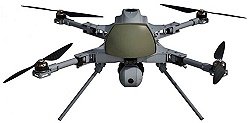
Turkey's STK Kargu was the first lethal autonomous weapon to
attack enemy combatants in warfare. Source: Wikipedia
One of the most significant impacts of UAVs on warfare is the enhancement of
situational awareness. Equipped with advanced sensors, cameras, and communication
systems, drones can provide real-time data and imagery, offering a comprehensive
view of the battlefield. This capability allows for more informed decision-making
and precise targeting, thereby reducing collateral damage and improving the efficiency
of military operations.
Unlike manned aircraft that are limited by human endurance and operational hours,
UAVs can stay aloft for extended periods, providing continuous coverage and support.
This persistence ensures that there are eyes on the target area longer, enabling
persistent surveillance and immediate action when required. The use of UAVs also
brings a strategic advantage in terms of force projection and deterrence as the
ability to deploy UAVs in hostile or inaccessible areas allows the military to project
power and assert dominance without solely relying on boots on the ground.
However, the rise of UAVs in warfare also presents ethical concerns about accountability,
decision-making processes, and the moral implications of remote strikes. The risk
of collateral damage and civilian casualties remains a significant concern, despite
the precision capabilities of UAVs. Nevertheless, we can expect these small platforms
to play a leading role in every conflict in the future.
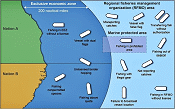 New Approach Finds Massive
Number of "Dark" Ships New Approach Finds Massive
Number of "Dark" Ships
An ocean conservation group is using satellite data and machine learning to find
"dark ships" that turn off their transponders to avoid detection, and its results
indicate that thousands of fishing and other vessels have been evading tracking
for years. While AIS transponders are required on most large ships, they can be
disabled or manipulated, and radio or satellite receivers have blind spots. To get
a more complete picture, four European Space Agency satellites provided more than
750,000 radar-generated images and nearly 2.5 million optical images of the ocean
between 2016 and 2021. The analysis revealed that as many as three-quarters of industrial
fishing vessels were not tracked, with high concentrations in Indonesia, south and
southeast Asia, and Africa's northern and western coasts.
 SpaceX Launches First Satellites
for Wireless Communications SpaceX Launches First Satellites
for Wireless Communications
SpaceX has launched the first six "direct to cell capable" Starlink satellites
into orbit from California's Vandenberg Space Force Base. The company says the satellites
will provide "seamless access to text, voice, and data for LTE phones across the
globe." The company says the satellites have more advanced modems that act like
base stations in space and plans to use cellular spectrum from its mobile partners,
such as T-Mobile, to make the service commercially available. SpaceX has partnered
with operators in Australia, Canada, New Zealand, Japan, Switzerland, and Chile,
and says messaging will be available first, followed by voice and data.
 Suit Says RF Caused Disabled
Person's Health to Decline Suit Says RF Caused Disabled
Person's Health to Decline
Children's Health Defense (CHD) has filed a complaint against wireless providers
on behalf of a disabled person in Idaho that claims the plaintiff's condition has
been worsened by electromagnetic radiation emitted from cell sites. It seeks to
remove or modify cell towers to provide accommodation as required by the Americans
with Disabilities Act (ADA). The plaintiff was diagnosed with Electromagnetic Sensitivity
(EMS) in California and then moved to less-populated Idaho to minimize his exposure.
However, shortly after, a wireless provider turned on a new site about 660 yards
from his home, after which, he claims, his condition worsened. "If the suit is successful,
the court will either remove the tower or order the defendants to modify their operations
to not so intensively beam RF radiation through his home," according to the plaintiff's
attorney.
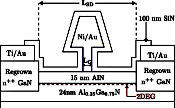 GaN Transistor Structure
Sets Frequency Record GaN Transistor Structure
Sets Frequency Record
Cornell University researchers say they have achieved a record high speed for
an aluminum gallium nitride (AlGaN)-channel transistor from an AlN/AlGaN/AlN quantum
well high-electron-mobility transistor (HEMT) structure. The Cornell team reports
cut-off and maximum oscillation frequencies of 67 and 166 GHz, breaking the 100
GHz barrier for the first time for AlGaN-channel HEMTs. The power was assessed using
a load-pull system at 10 GHz, and power density reached 20% and 2 W/mm with a gain
of 5.2 dB at 20% power-added efficiency. Combined with higher performance, AlGaN
HEMTs have the potential to deliver systems with higher power density.
Anatech Electronics Introduces a New Line of Suspended
Stripline and Waveguide Type RF Filters
Check out Our Filter Products
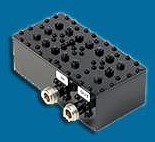
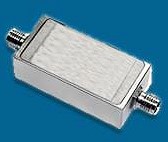
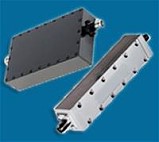
Cavity Band Pass Filters
LC Band Pass Filters Cavity Bandstop/Notch Filter
About Anatech Electronics
Anatech Electronics, Inc. (AEI) specializes in the design and manufacture of
standard and custom RF and microwave filters and other passive components and subsystems
employed in commercial, industrial, and aerospace and applications. Products are
available from an operating frequency range of 10 kHz to 30 GHz and include cavity,
ceramic, crystal, LC, and surface acoustic wave (SAW), as well as power combiners/dividers,
duplexers and diplexers, directional couplers, terminations, attenuators, circulators,
EMI filters, and lightning arrestors. The company's custom products and capabilities
are available at www.anatechelectronics.com.
Contact:
Anatech Electronics, Inc.
70 Outwater Lane
Garfield, NJ 07026
(973)
772-4242
sales@anatechelectronics.com
Posted January 31, 2024
|





























 By Sam Benzacar
By Sam Benzacar
 New Approach Finds Massive
Number of "Dark" Ships
New Approach Finds Massive
Number of "Dark" Ships  SpaceX Launches First Satellites
for Wireless Communications
SpaceX Launches First Satellites
for Wireless Communications  Suit Says RF Caused Disabled
Person's Health to Decline
Suit Says RF Caused Disabled
Person's Health to Decline  GaN Transistor Structure
Sets Frequency Record
GaN Transistor Structure
Sets Frequency Record 




